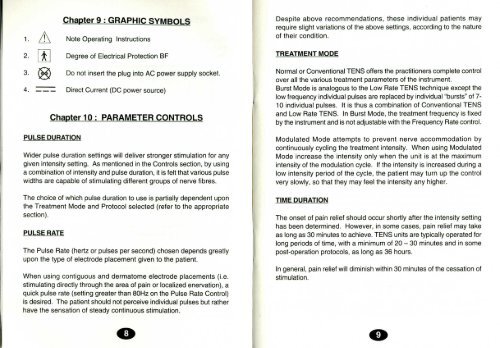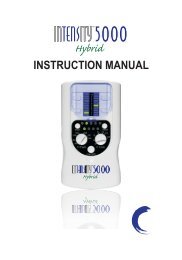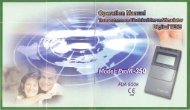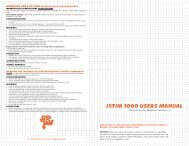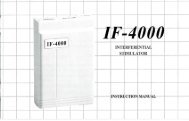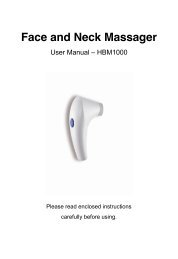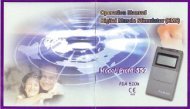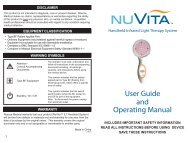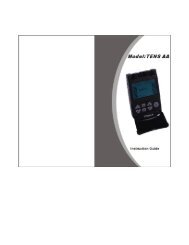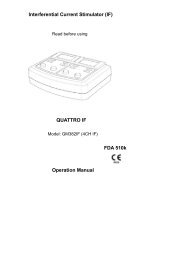Promed 300 Operations Manual
Promed 300 Operations Manual
Promed 300 Operations Manual
Create successful ePaper yourself
Turn your PDF publications into a flip-book with our unique Google optimized e-Paper software.
1.<br />
2 li<br />
3. d5<br />
Chapter 9 : GRAPHIC SYMBOLS<br />
Note Operating Instructions<br />
Degree of Electrical Protection BF<br />
Do not insert the plug into AC power supply socket.<br />
Direct Current (DC power source)<br />
Chapter 10 : PARAMETER CONTROLS<br />
PULSE DURATION<br />
Wider pulse duration settings will deliver stronger stimulation for any<br />
given intensity setting. As mentioned in the Controls section, by using<br />
a combination of intensity and pulse duration, it is felt that various pulse<br />
widths are capable of stimulating different groups of nerve fibres.<br />
The choice of which pulse duration to use is partially dependent upon<br />
the Treatment Mode and Protocol selected (refer to the appropriate<br />
section).<br />
PULSE RATE<br />
The Pulse Rate (hertz or pulses per second) chosen depends greatly<br />
upon the type of electrode placement given to the patient.<br />
When using contiguous and dermatome electrode placements (i.e.<br />
stimulating directly through the area of pain or localized enervation), a<br />
quick pulse rate (setting greater than 80Hz on the Pulse Rate Control)<br />
is desired. The patient should not perceive individual pulses but rather<br />
have the sensation of steady continuous stimulation.<br />
o<br />
Despite above recommendations, these individual patients may<br />
require slight variations of the above settings, according to the nature<br />
of their condition.<br />
TREATMENT MODE<br />
Normal or Conventional TENS offers the practitioners complete control<br />
over all the various treatment parameters of the instrument.<br />
Burst Mode is analogous to the Low Rate TENS technique except the<br />
low frequency individual pulses are replaced by individual "bursts" of 7-<br />
10 individual pulses. It is thus a combination of Conventional TENS<br />
and Low Rate TENS. In Burst Mode, the treatment frequency is fixed<br />
by the instrument and is not adjustable with the Frequency Rate control.<br />
Modulated Mode attempts to prevent nerve accommodation by<br />
continuously cycling the treatment intensity. When using Modulated<br />
Mode increase the intensity only when the unit is at the maximum<br />
intensity of the modulation cycle. If the intensity is increased during a<br />
low intensity period of the cycle, the patient may turn up the control<br />
very slowly, so that they may feel the intensity any higher.<br />
TIME DURATION<br />
The onset of pain relief should occur shortly after the intensity setting<br />
has been determined. However, in some cases, pain relief may take<br />
as long as 30 minutes to achieve. TENS units are typically operated for<br />
long periods of time, with a minimum of 20 - 30 minutes and in some<br />
post-operation protocols, as long as 36 hours.<br />
In general, pain relief will diminish within 30 minutes of the cessation of<br />
stimulation.<br />
o


